How to Grow Oranges: Complete Cultivation and Care Guide
- March 1, 2024
- 0 comment
Oranges, with their delightful aroma and burst of flavor, are a favorite worldwide. Growing your own orange tree can be a rewarding experience, offering both aesthetic pleasure and a source of fresh fruit. This guide will walk you through the process of cultivating your own orange trees, from planting to harvest.

Nutritional Benefits of Oranges
| Benefit | Description |
|---|---|
| High in Vitamin C | Oranges are an excellent source of Vitamin C, which is vital for the repair and growth of tissues, helps in wound healing, and supports the immune system. |
| Antioxidant Properties | Contains antioxidants like flavonoids, carotenoids, and ascorbic acid, which help fight free radicals, reducing the risk of chronic diseases. |
| Heart Health | The fiber, potassium, and choline in oranges support heart health. Potassium helps manage blood pressure, while the fiber reduces cholesterol levels. |
| Skin Health | The antioxidants and Vitamin C in oranges help in maintaining skin health by preventing aging and promoting skin repair. |
| Fiber Content | Oranges are a good source of dietary fiber which aids in digestion and helps maintain a healthy gut. It also contributes to better blood sugar control. |
| Lowers Stroke Risk | Studies have shown that the high vitamin C content in oranges can lower the risk of certain types of stroke, especially in women. |
| Weight Management | Being low in calories and high in fiber, oranges can be a beneficial addition to a diet for weight management. |
| Hydration | Oranges have a high water content which helps in hydrating the body. |
| Eye Health | The vitamin A, vitamin C, and potassium in oranges are crucial for eye health and may help prevent age-related macular degeneration. |
| Cancer Prevention | Compounds in oranges, like D-limonene and hesperidin, have been associated with cancer prevention, particularly skin, lung, and breast cancer. |
List on How To Grow Oranges
- Selecting the Right Variety
- Planting Your Tree
- Caring for Your Orange Tree
- Harvesting Your Oranges
- Pest and Disease Management
Selecting the Right Variety
Choosing the Right Type
Navel Oranges
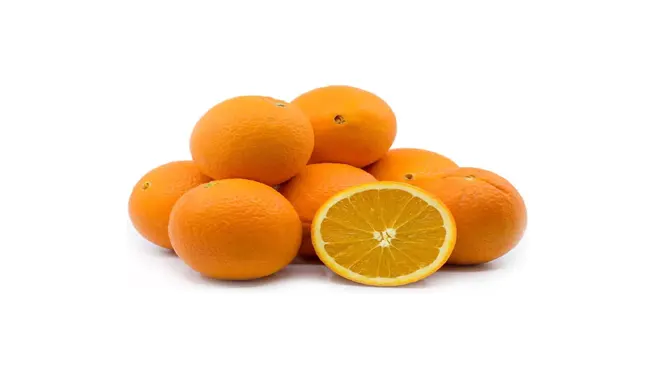
- These are popular for eating fresh due to their sweet flavor and lack of seeds. The “navel” at the bottom of the fruit is a distinguishing feature. They are not the best for juicing as their juice turns bitter quickly after exposure to air.
Valencia Oranges
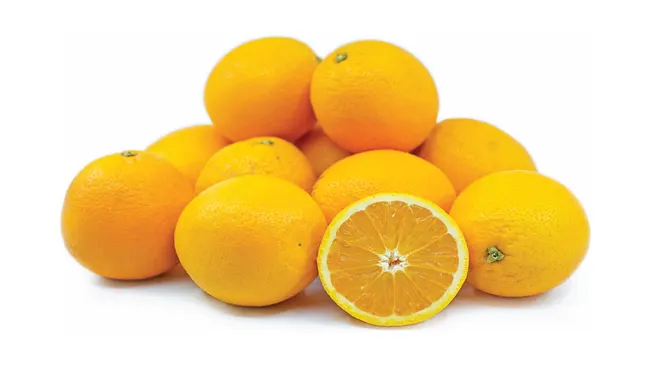
- Known for their juiciness and sweet flavor, Valencia oranges are a top choice for making orange juice. They have seeds and a thinner peel compared to Navel oranges. These trees can produce fruit almost year-round in the right climate.
Blood Oranges

- Named for their deep red flesh, these oranges are less common but highly prized for their unique flavor, which has hints of raspberry or pomegranate. They are excellent for both juicing and eating fresh, and are popular in culinary uses due to their vibrant color.
- Other Varieties : There are many other varieties like the ‘Hamlin’, ‘Pineapple’, and ‘Cara Cara’ oranges, each with unique characteristics in terms of flavor, juice content, and peel thickness.
Climate Considerations

- Subtropical Regions: Most orange varieties thrive in subtropical regions where temperatures are warm but not excessively hot. These areas typically have a distinct winter season, which is crucial for the development of sweet flavors in the fruit.
- Tropical Climates: In more tropical climates, select varieties that can tolerate constant warmth and humidity. Some types of Valencia and local varieties are well-suited to these conditions.
- Cooler Climates: For areas with cooler temperatures, certain varieties like the ‘Satsuma’ mandarin (a type of orange) might be more appropriate. These can tolerate and even require cooler temperatures for a period to produce fruit. However, true oranges generally struggle in cold climates.
- Microclimate Considerations: Even within your garden, microclimates can impact growth. Planting near a south-facing wall, for example, can provide extra warmth and protection for the tree in cooler areas.
- Soil and Elevation: Apart from temperature, consider soil type and elevation. Oranges prefer well-draining soil and can be sensitive to high salinity or alkalinity. In hilly areas, elevation can affect temperature and humidity, influencing which varieties will thrive.
Planting Your Tree
Choosing a Location
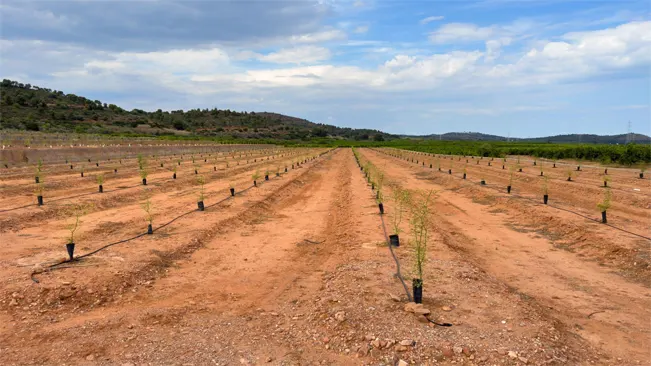
- Sunlight is Key: Orange trees need full sun to produce a healthy amount of fruit. The chosen location should receive at least 6-8 hours of direct sunlight each day. Less sunlight can lead to fewer fruits and a weaker tree.
- Protection from Wind: It’s also important to consider wind exposure. Choose a spot that is somewhat sheltered from strong winds which can damage the tree and its fruit.
- Space for Growth: Ensure there’s enough room for the tree to grow. Orange trees can spread wide and tall, so consider future growth to avoid overcrowding.
Soil Preparation
- Soil Quality: Oranges prefer soil that’s rich in organic matter. This helps retain moisture and provides essential nutrients. If your soil is heavy clay or sandy, amend it with compost or well-rotted manure to improve texture and fertility.
- pH Balance: The ideal pH for orange trees is between 6.0 and 8.0. If your soil is too acidic or alkaline, you can adjust the pH with lime (to raise pH) or sulfur (to lower pH). It’s a good idea to test your soil’s pH before making any adjustments.
- Drainage: Good drainage is crucial to prevent waterlogging and root diseases. If your soil doesn’t drain well, consider planting the tree on a slight mound to improve drainage.
Planting
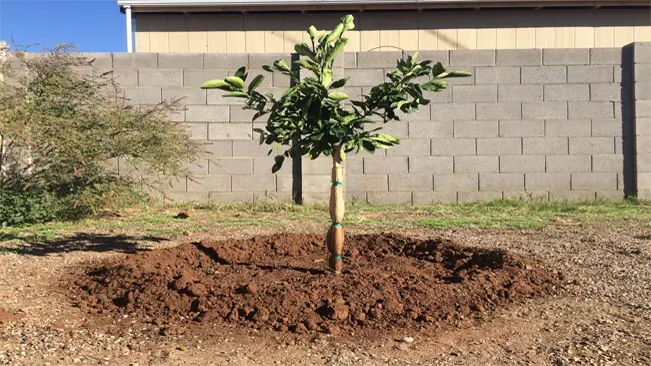
- Timing: Springtime, after the last frost, is ideal for planting. This gives the tree a full growing season to establish itself before winter.
- Planting Depth and Width: Dig a hole that is twice as wide as the root ball but no deeper. Planting too deep can cause stem rot.
- Root Ball Care: Gently loosen the roots if they are bound. This encourages them to spread out into the surrounding soil.
- Watering After Planting: Once planted, water the tree thoroughly to settle the soil around the roots and eliminate air pockets. This initial watering is crucial for establishing a good root system.
Caring for Your Orange Tree
Watering
Proper watering is vital for the health and fruit production of your orange tree. Here are key points to consider:
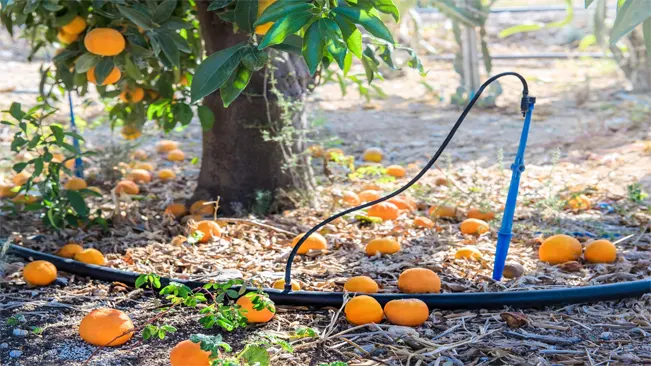
- Frequency: The watering needs of an orange tree vary depending on its age, the season, and the climate. Young trees require more frequent watering, generally once or twice a week. Mature trees can be watered less often but may need more water per session.
- Amount: The goal is to keep the soil consistently moist but not waterlogged. Typically, orange trees need about 1 to 1.5 inches of water per week, including rainfall.
- Method: Drip irrigation or a soaker hose is ideal as they deliver water directly to the roots and minimize water loss due to evaporation. Avoid wetting the leaves, as this can promote fungal diseases.
- Signs of Over/Under-Watering: Over-watering can lead to root rot, indicated by yellowing leaves and a general decline in tree health. Under-watered trees will have dry, wilting leaves and poor fruit development.
Fertilization
Fertilizing your orange tree ensures it gets all the necessary nutrients for growth and fruit production.
- Type of Fertilizer: Use a fertilizer specifically formulated for citrus trees. These fertilizers typically have a higher nitrogen content and also provide essential micronutrients like iron, manganese, and zinc.
- Schedule: Fertilize in early spring as new growth begins, in late spring, and again in mid-summer. Avoid fertilizing in late fall or winter, as this can spur growth at a time when the tree should be getting ready for colder weather.
- Application: Follow the package instructions for the correct amount. Generally, you should spread the fertilizer evenly under the canopy of the tree and water it in thoroughly.
Pruning
Pruning is essential for maintaining the health and productivity of your orange tree.
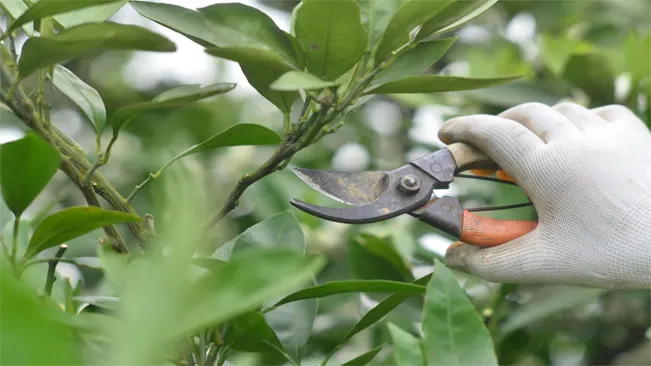
- When to Prune: The best time for pruning is in late winter or early spring before the new growth starts.
- Purpose: Pruning helps in shaping the tree, removing diseased or dead wood, and improving air circulation within the canopy. Good air circulation is critical for reducing disease incidence.
- How to Prune: Make clean cuts with sharp pruning tools. Remove any branches that are crossing, rubbing against each other, or growing inward towards the center of the tree. Also, trim off any suckers or water sprouts, as these can drain energy from the tree.
- Moderation: Be cautious not to over-prune, as this can stress the tree and reduce fruit production. Typically, removing about 10-20% of the canopy annually is sufficient.
Harvesting Your Oranges
Timing
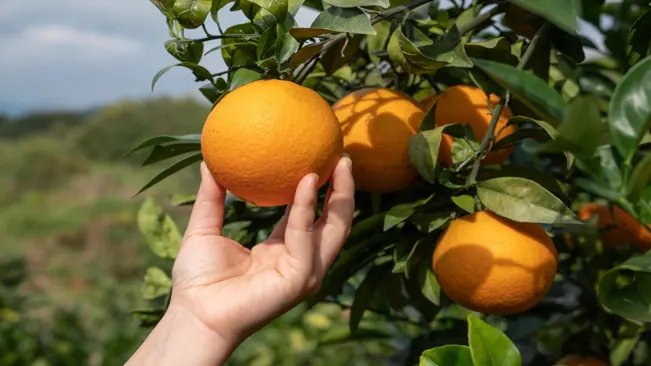
- Seasonal Variation: While oranges generally ripen in winter, the exact timing can vary based on the variety and local climate. In some warmer regions, oranges may ripen as early as late fall.
- Monitoring Ripeness: Since the external color of an orange isn’t always a reliable ripeness indicator (some oranges may re-green due to temperature fluctuations), it’s important to periodically taste-test the fruit. The sweetness and juiciness are better indicators of ripeness.
- Consistent Observation: Start checking for ripeness when the oranges begin to turn color. This transition usually indicates they’re approaching maturity.
Harvesting Method
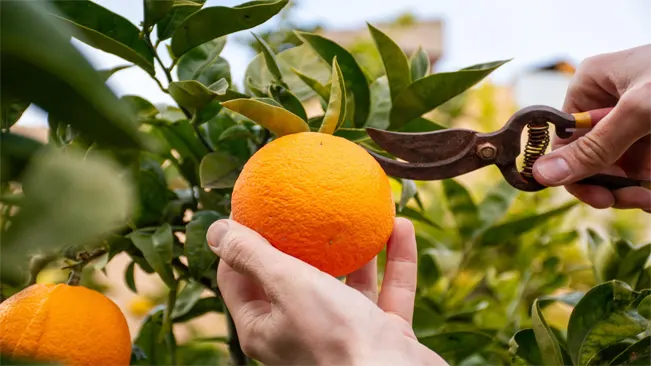
- Using Pruning Shears: To harvest, use clean, sharp pruning shears. Cut the fruit from the tree, leaving a short piece of stem attached. This method reduces the risk of damaging the fruit and the tree.
- Avoid Pulling: Directly pulling the fruit from the tree can damage both the fruit and the branch. It might also lead to the removal of the button (the small area where the fruit attaches to the tree), which can shorten the fruit’s shelf life.
- Gentle Handling: Handle the oranges gently to avoid bruising. Bruised fruit deteriorates quicker and can affect other stored fruits.
Post-Harvest Care
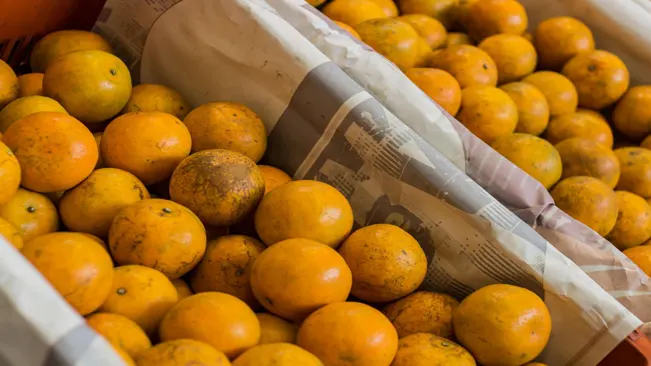
- Storage: Store oranges at room temperature if they’re going to be consumed within a few days. For longer storage, refrigerate them to extend their shelf life.
- Checking for Damage: Inspect the harvested oranges for any signs of damage or disease. Damaged or diseased fruits should be used first or discarded to prevent them from affecting healthy ones.
- Curing: Some varieties benefit from a short curing period at room temperature, which can enhance flavor and juiciness.
Pest and Disease Management
Pest Management
- Aphids: These small, sap-sucking pests can cause leaf curl and stunt growth. They also excrete a sticky substance called honeydew, which can lead to sooty mold. Control methods include using horticultural oils, insecticidal soaps, or introducing natural predators like ladybugs.
- Mites: Spider mites are tiny pests that can cause leaves to yellow and drop. They thrive in hot, dry conditions. Regularly spraying the tree with water can help manage mite populations, as can the use of miticides if infestations are severe.
- Citrus Leaf Miners: These larvae tunnel through leaves, creating distinctive silvery trails. While they don’t typically harm the tree’s health, severe infestations can reduce its vigor. Biological control methods include using parasitic wasps, and systemic insecticides can also be effective.
Disease Prevention
- Fungal Diseases: Examples include root rot, anthracnose, and citrus scab. Good cultural practices are key in preventing these. This includes:
- Proper Watering: Over-watering can lead to root rot, while under-watering can stress the tree, making it more susceptible to diseases. Water deeply but infrequently to encourage strong root growth.
- Air Circulation: Proper pruning helps maintain good air circulation within the canopy, reducing the risk of fungal diseases.
- Avoiding Leaf Wetness: When watering, try to avoid wetting the leaves. This reduces the likelihood of fungal spores germinating on the leaf surface.
- Citrus Canker: This is a bacterial disease that causes lesions on leaves, stems, and fruit. It’s spread by rain splash and contaminated pruning tools. To prevent it, practice good sanitation, avoid pruning in wet weather, and use resistant varieties if canker is a known problem in your area.
- Greasy Spot: A fungal disease that causes yellow-brownish blisters on leaves, leading to leaf drop. Control involves applying copper-based fungicides and proper sanitation.
Conclusion
Growing oranges can be a delightful and fruitful endeavor. With patience and proper care, you can enjoy fresh, homegrown oranges right from your backyard. Remember, successful orange cultivation starts with understanding the needs of your specific orange tree variety and adapting your care routine accordingly.
FAQs (Frequently Asked Questions)
- What climate is best for growing oranges?
- Oranges thrive in subtropical to tropical climates, preferring consistent warm temperatures. They need plenty of sunlight and do not tolerate frost well.
- Oranges thrive in subtropical to tropical climates, preferring consistent warm temperatures. They need plenty of sunlight and do not tolerate frost well.
- How much sun do oranges need?
- Orange trees require at least 6-8 hours of direct sunlight daily. Adequate sun exposure is essential for fruit production and overall health.
- Orange trees require at least 6-8 hours of direct sunlight daily. Adequate sun exposure is essential for fruit production and overall health.
- When is the best time to plant orange trees?
- The best time to plant orange trees is in the spring after the threat of frost has passed. This gives the tree time to establish itself before winter.
- The best time to plant orange trees is in the spring after the threat of frost has passed. This gives the tree time to establish itself before winter.
- How often should I water my orange tree?
- Water young trees once or twice a week, allowing the soil to dry out slightly between waterings. Mature trees need watering less frequently, but with more water each time.
- Water young trees once or twice a week, allowing the soil to dry out slightly between waterings. Mature trees need watering less frequently, but with more water each time.
- What type of soil do orange trees prefer?
- Orange trees prefer well-draining soil that’s rich in organic matter. A slightly acidic to neutral pH (6.0-7.0) is ideal.
- Orange trees prefer well-draining soil that’s rich in organic matter. A slightly acidic to neutral pH (6.0-7.0) is ideal.
- Do I need to fertilize my orange tree? If so, how often?
- Yes, fertilize with a citrus-specific fertilizer. Apply it in early spring, late spring, and mid-summer, following the manufacturer’s instructions.
- Yes, fertilize with a citrus-specific fertilizer. Apply it in early spring, late spring, and mid-summer, following the manufacturer’s instructions.
- How do I prune an orange tree?
- Prune to remove dead or diseased branches, shape the tree, and improve air circulation. It’s best to prune in late winter or early spring before new growth begins.
- Prune to remove dead or diseased branches, shape the tree, and improve air circulation. It’s best to prune in late winter or early spring before new growth begins.
- How long does it take for an orange tree to bear fruit?
- Orange trees can take 3-5 years to bear fruit when grown from a graft, and up to 15 years if grown from seed.
- Orange trees can take 3-5 years to bear fruit when grown from a graft, and up to 15 years if grown from seed.
- What are common pests and diseases affecting orange trees?
- Common pests include aphids, spider mites, and citrus leaf miners. Diseases like citrus canker and root rot can also affect orange trees.
- Common pests include aphids, spider mites, and citrus leaf miners. Diseases like citrus canker and root rot can also affect orange trees.
- How do I know when oranges are ripe and ready to pick?
- Oranges are typically ready to harvest when they have fully changed color and are slightly soft to the touch. Taste-testing is often the best way to determine ripeness.

Kristine Moore
Forestry AuthorI'm Kristine Moore, a seasoned garden landscaping professional with over 30 years of experience. My extensive career has been dedicated to transforming outdoor spaces into stunning, sustainable landscapes. With a deep understanding of horticulture, design principles, and environmental stewardship, I have become a respected figure in the field, known for creating harmonious, visually appealing, and eco-friendly gardens. My commitment to excellence and continuous learning in landscaping trends and techniques has solidified my reputation as an expert in garden design and implementation.







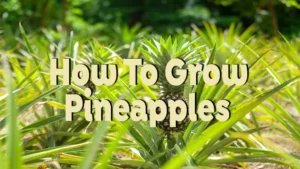





Leave your comment